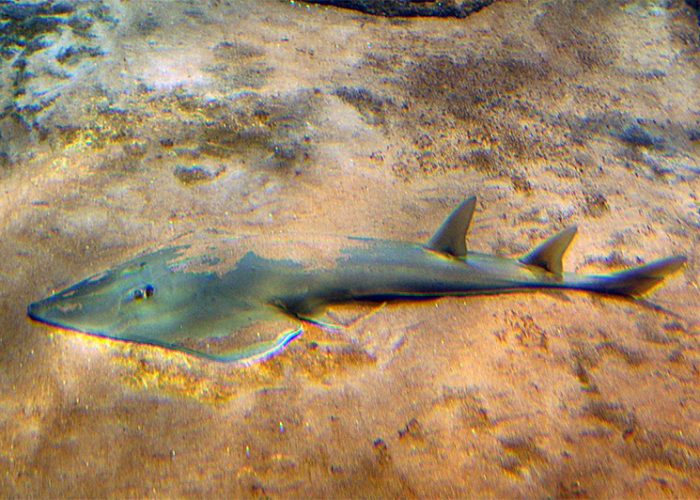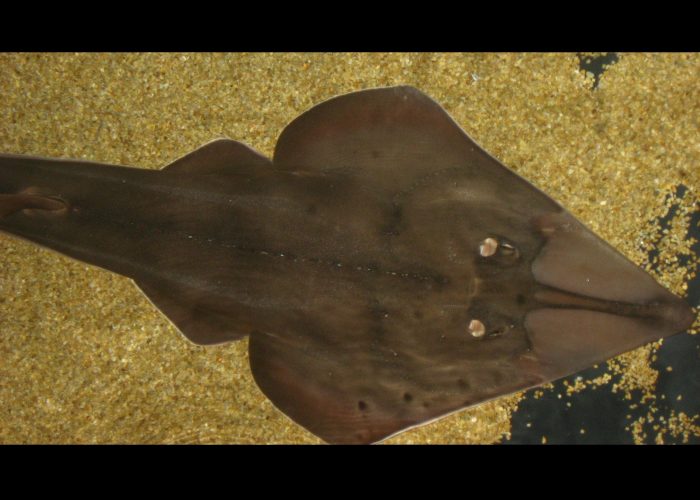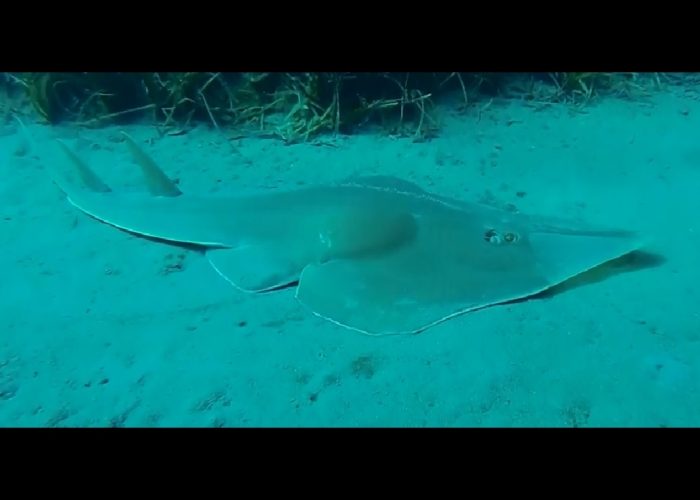Glaucostegus cemiculus
- Common name : Blackchin Guitarfish, Giant guitarfish
- Order: Rhinopristiformes
- Family: Glaucostegidae
- Synonyms: Rhinobatos cemiculus, Glaucostegus petiti
- Misidentifications: None.
Short description
Large to very large species with an elongated tubular body. Head, body and pectoral fins are combined in a triangular disc, with rostral ridges narrowly separated posteriorly and almost joined anteriorly. Small denticles cover a rough skin. Distance between dorsal fins is about equal to that between the base of the first dorsal fin and the axilla of the pectoral fin. A row of thorns from nape to the first dorsal fin. Thorns along the rostral cartilage, around orbits and spiracles, between dorsal fins.
Color: Beige to brownish dorsal surface. White ventral surface.
Measurements:
- Total length (TL): 180 cm (max 265 cm).
- Weight: up to 49.9 kg
Swimming pattern: Axial-undulatory locomotion.
Biology / Ecology
Feeds mainly on benthic crustaceans and small fishes.
Reproduction: Viviparous (aplacental viviparity with histotrophy). Annual reproduction cycle. Size at maturity in Mediterranean (TL): 110-138 cm female, 100-112 cm male. Size at maturity in Senegal (TL): 163 cm female at 5.1 years, 155 cm male at 3.9 years. Mature at smaller size in the Mediterranean Sea: males 100-110 cm TL, females ~110 cm TL. Juveniles per litter per year: 1-6. Size at birth (TL): ~34 cm.
Habitat: Benthic species living on sandy and muddy bottoms from nearshore to 100 m of depth on the continental shelf.
Generally ambush crustaceans and small fish by pinning them down with their long snouts and then sucking them into their mouths.
Distinguishing characteristics
- Rostral ridges narrowly separated.
- Distances between dorsal fins are about equal to that between the base of the first dorsal fin and the axilla of the pectoral fin.
Glaucostegidae: Snout elongated and pointed. Strongly depressed trunk. Pectoral fins enlarged.
Distribution
Worldwide: Atlantic, from Northern Portugal to Angola.
Mediterranean: Southern and eastern Mediterranean basin. A laying area has been identified from the Gulf of Gabès. One recent record from the Black Sea.
- Occurence: Abundant.
- Latest records: Cyprus (2018-2022), Alexandria – Egypt (2018-2020), Tunisia (2007-2008, 2016-2017), Lebanon (2012-2014), Izmir bay – Turkey (2013), Syria (2003), Iskenderun bay – Turkey (2010-2011), Black Sea (2009-2018), Adriatic Sea (before 1948), Ligurian Sea and upper Tyrrhenian Sea (before 1898).

Any recent observation not on the map?
Contact us!
Conservation
Threats: High fishing pressure from West Africa. Taken as bycatch by bottom trawlers with commercial value in some ports of the Mediterranean Sea.
Protection level:
- Global: Critically Endangered (IUCN 2019, last assessment: 2018)
Key references
- Carpentieri P., Nastasi A., Sessa M., Srour A. 2021. Incidental catch of vulnerable species in Mediterranean andBblack Sea fisheries – A review. General Fisheries Commission for the Mediterranean – Studies and Reviews 101: I-317.
- Giovos I., Serena F., Katsada D., Anastasiadis A., Barash A., Charilaou C., Hall-Spencer J.M.,Crocetta F.,Kaminas A., Kletou D, Maximiadi M., Minasidis V., Moutopoulos D.K., Aga-Spyridopoulou R.N., Thasitis I., Kleitou P. 2021. Integrating literature, biodiversity databases, and citizen-science to reconstruct the checklist of Chondrichthyans in Cyprus (Eastern Mediterranean Sea). Fishes 6(3): 24.
- Golani D. 2005. Checklist of the Mediterranean fishes of Israel. Zootaxa 947(1): 1-90.
- Lteif M., Mouawad R., Jemaa S., Khalaf G., Lenfant P., Verdoit-Jarraya M. 2016. The length-weight relationships of three sharks and five batoids in the Lebanese marine waters, eastern Mediterranean. Egypt. J. Aquat. Res. 42: 475–477.
- O’Keefe M., Bengil EG., Palmer JL, Beton D, Çağlar Ç., Godley B.J, Özkan M., Snape R.T.E., Broderick A.C. 2023. Diversity and distribution of elasmobranchs in the coastal waters of Cyprus: using bycatch data to inform management and conservation. Front. Mar. Sci. 10: 1181437.



